There was a moment in the Scottish League Cup final last February when Celtic’s right No 8, Aaron Mooy, roamed towards the other side of their attack to combine with Reo Hatate — their left No 8 — and Greg Taylor, the left-back who would set up the opening goal in a game which saw Ange Postecoglou’s team win another trophy.
Postecoglou’s fingerprints were all over that Celtic squad by then, halfway through his second season in charge. And the Australian head coach has transformed Tottenham Hotspur’s results, performances and aesthetics since he was appointed last summer, while sticking to his core beliefs and footballing principles.
That move for a Kyogo Furuhashi goal in a 2-1 win against arch-rivals Rangers at Hampden Park in Glasgow wasn’t a one-off.
Under Postecoglou, Celtic’s midfielders roamed frequently to create overloads on one side of the pitch, with the inside positioning of the full-backs aiding them.
It is something that has been noticeable at Spurs this season, where often one of the midfielders — usually the more creative one — overloads the side where the ball is, to help with the passing combinations there.
Against Everton on December 23, for example, Oliver Skipp started as their deepest midfielder, behind Pape Sarr and Dejan Kulusevski.
In the build-up to Tottenham’s first goal in a 2-1 win, Kulusevski — who mainly operated on the left side of midfield — roams to a more central position with full-backs Emerson Royal and Pedro Porro in narrow positions, which allows centre-back Cristian Romero to play a ball directly to forward Brennan Johnson…

… who sets it back to Porro. Meanwhile, Kulusevski has moved across to the right side to overload that area as Royal maintains his narrow position in midfield. The Brazilian’s positioning doesn’t only act as an attacking threat, but it also allows Kulusevski to roam to the other side, because if Tottenham lose the ball centrally here, there’s an additional player to help Skipp win it back quickly.
Porro plays the pass to Sarr…

… and the positioning of Kulusevski attracts Everton’s left centre-back, Jarrad Branthwaite — forcing him to move up. Sarr then finds Johnson’s run, with the help of a dummy from Kulusevski…
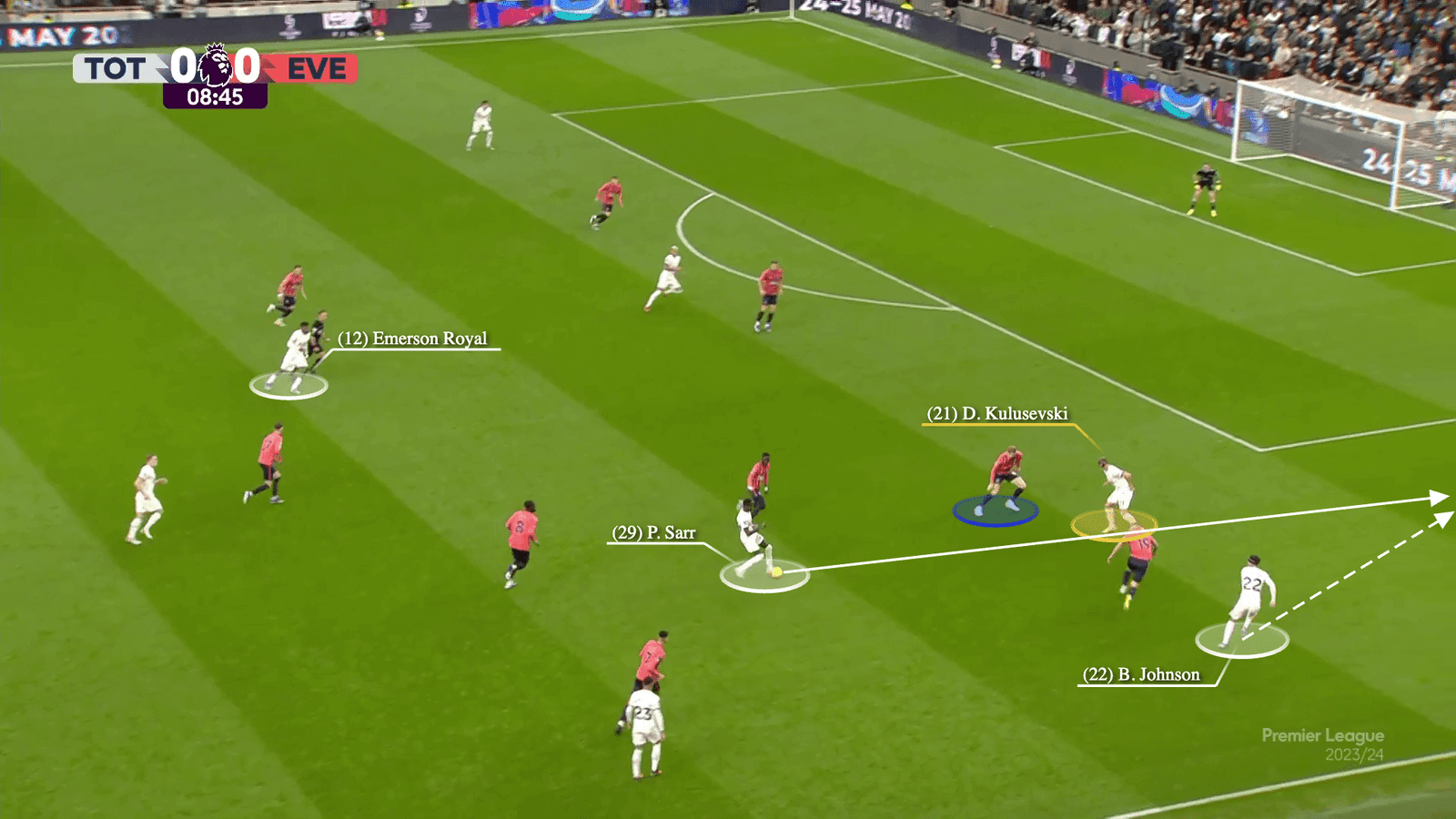
… whose role in moving Branthwaite out of position creates more space in the Everton box, which helps Johnson find Richarlison’s run…

… before the Brazilian makes it 1-0.

Another example is Spurs’ first in the 4-1 win against Newcastle United two weeks earlier, when Yves Bissouma played as the No 6 behind Kulusevski and Sarr.

Here, Sarr is playing deeper, with Porro moving forward to a position between the lines. On the left side of the pitch, full-back Destiny Udogie is also occupying a narrow position…
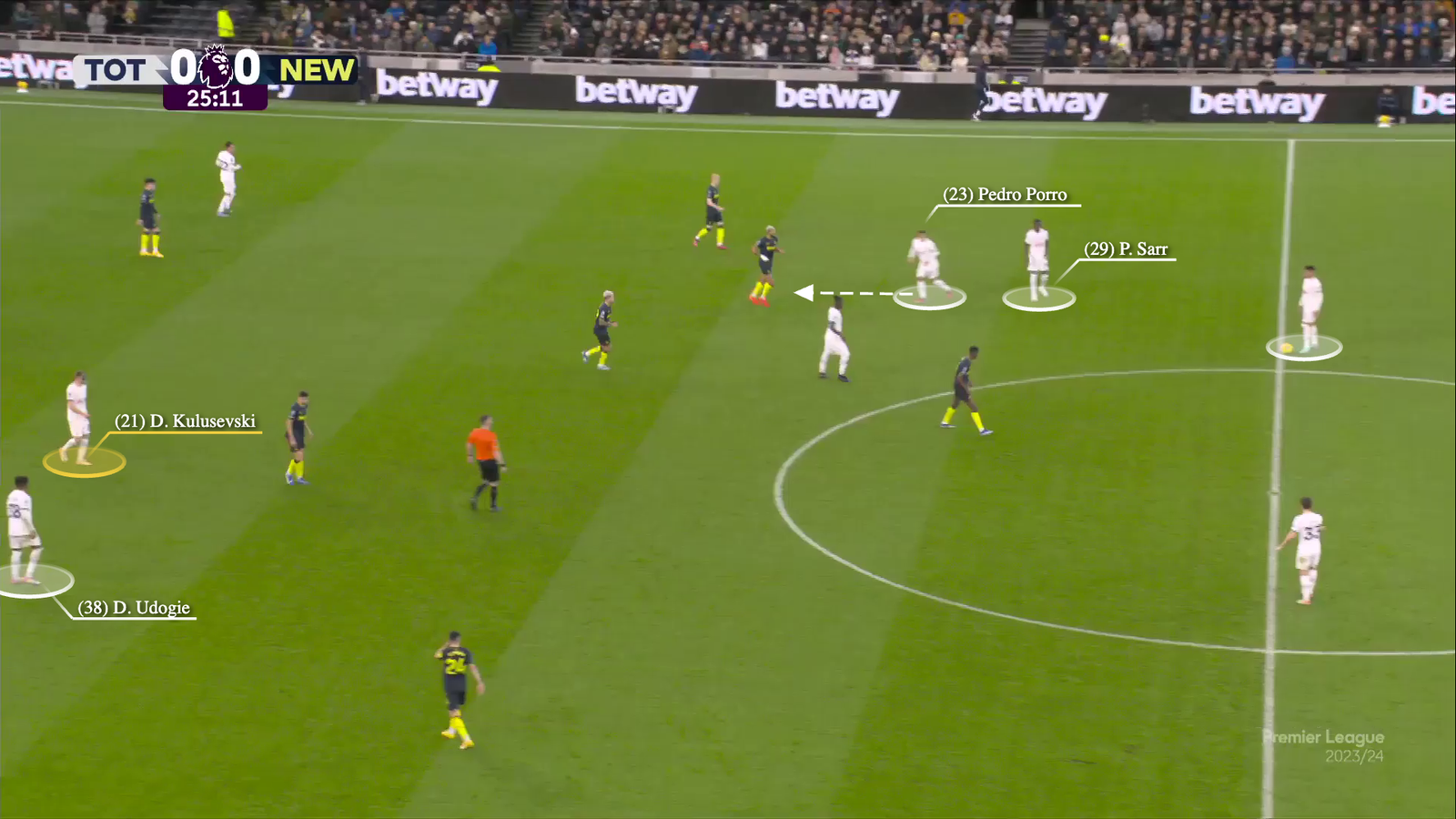
… which means that Kulusevski can roam towards the other side, with Tottenham still maintaining an attacking threat in the left half-space and a player to counter-press in midfield if needed.
The Sweden international’s movement, in conjunction with Porro’s positioning, leaves Fabian Schar unable to move up and commit to either of them, fearing quick passing combinations which may catch him out. This allows Romero to then find Kulusevski…

… and the latter plays the ball on to Porro, who switches it to Udogie with Kieran Trippier unable to move out and press Tottenham’s left-back because of the presence of Son Heung-min (out of frame to the left in the screengrab below) on that flank.
While that is happening, Kulusevski moves back to his original position…

… grabbing the attention of Newcastle’s right centre-back, Jamaal Lascelles, as Udogie plays the ball wide to Son.
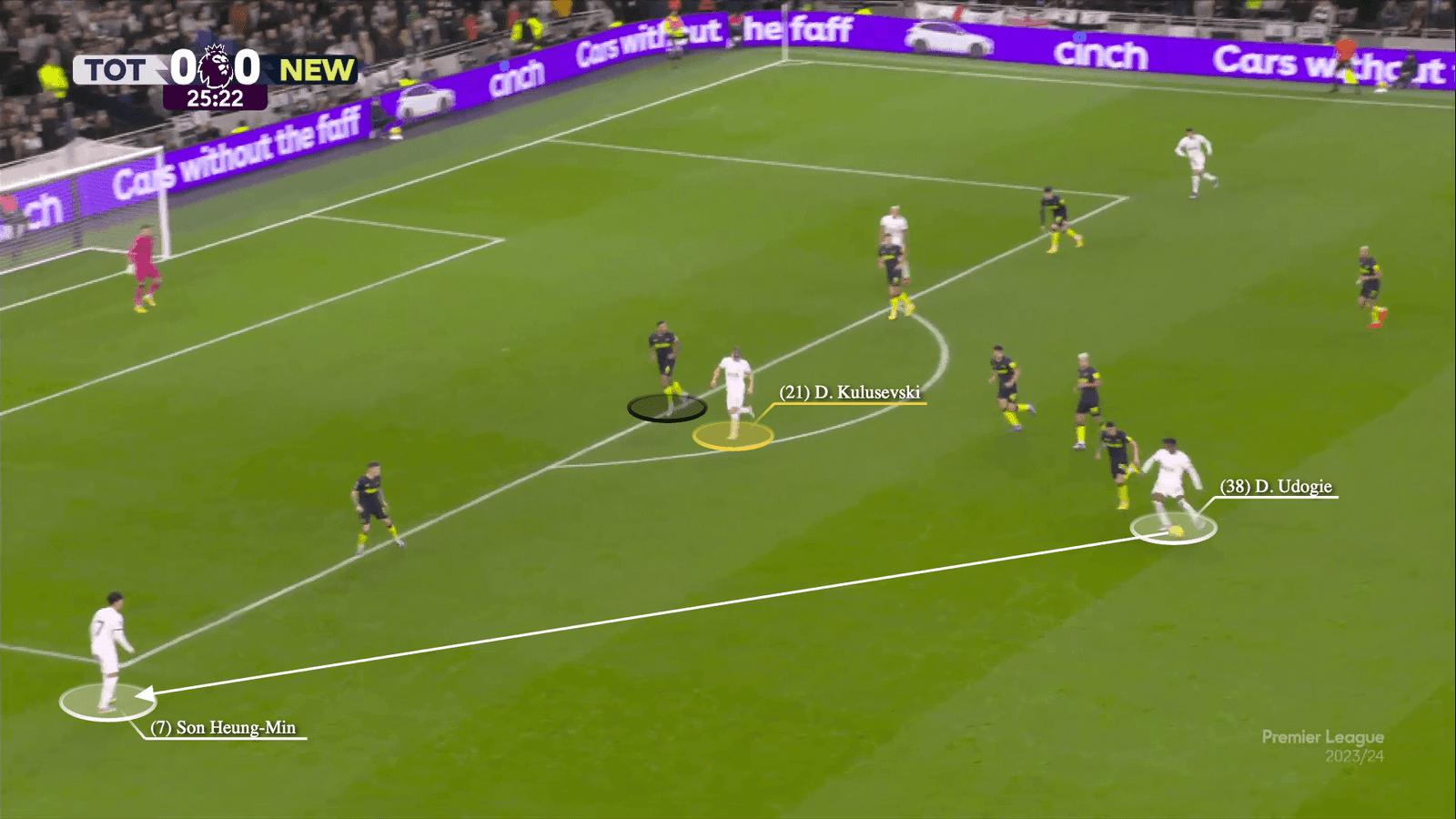
With Newcastle’s back four occupied by Tottenham’s front three and Kulusevski, Udogie makes an untracked central run into the penalty area…

… which is found by Son, and the Italian scores to give Spurs the lead.


While Udogie and Kulusevski were providing passing options inside the penalty box, Porro, Sarr and Bissouma were in position to win the ball back in case Son’s cross was cleared.

The dynamism and flexibility of Tottenham’s attacking play makes them effective going forward, but there are principles guiding it.
“We are very structured, but hopefully it doesn’t look that way,” Postecoglou said in August, shortly after being hired.
“What is a rigid structure looks very fluid because guys understand that as long as there is movement out there — they are looking for spaces and other guys are filling the spaces they leave — it doesn’t really matter where they pop up or where they go.
“But there is a discipline within that. It’s not just about sort of running anywhere, it’s about going to the areas where we work on constantly. If it looks fluid, that makes us harder to stop.”
In another example, away against Crystal Palace on October 27, Tottenham’s starting midfield consisted of Bissouma, Sarr and James Maddison.

From an attacking throw-in, Maddisom roams to the right side to overload that area.

Romero’s pass to Porro stretches Palace’s back four, which allows Sarr to attack the space between full-back Tyrick Mitchell and centre-back Marc Guehi, who can’t shift across because he is marking Kulusevski.
The Palace player dropping to defend Sarr is midfielder Jefferson Lerma, but it’s important to point out two positions here: those of Maddison and Royal. The Brazilian is in a narrower position to help Bissouma win the ball back in midfield, while the England international is unmarked during his side’s overload on the right…

… which allows him to be the first to the ball after Sarr’s initial cross is deflected.

Tottenham get lucky as Maddison’s cross is put into his own net by Joel Ward. But without overloading the right side of the attack in the first place, the former Leicester man wouldn’t have been in a position to play that ball.
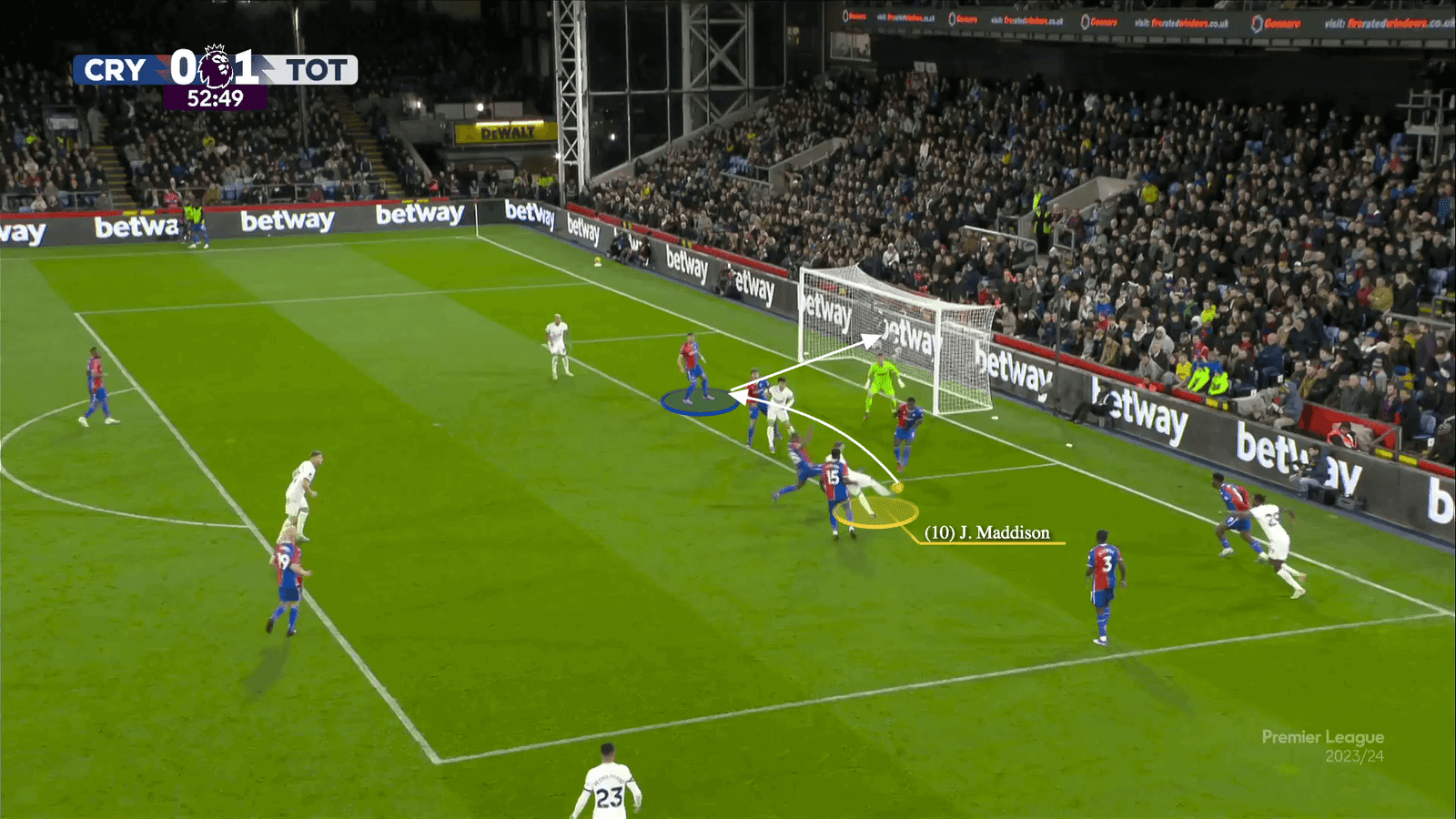
The latest example of these midfielder roams is Rodrigo Bentancur’s goal against Manchester United on January 14.
The Uruguayan was operating on the right of Tottenham’s midfield that day, with Skipp on the left and Pierre-Emile Hojbjerg in a deeper role.
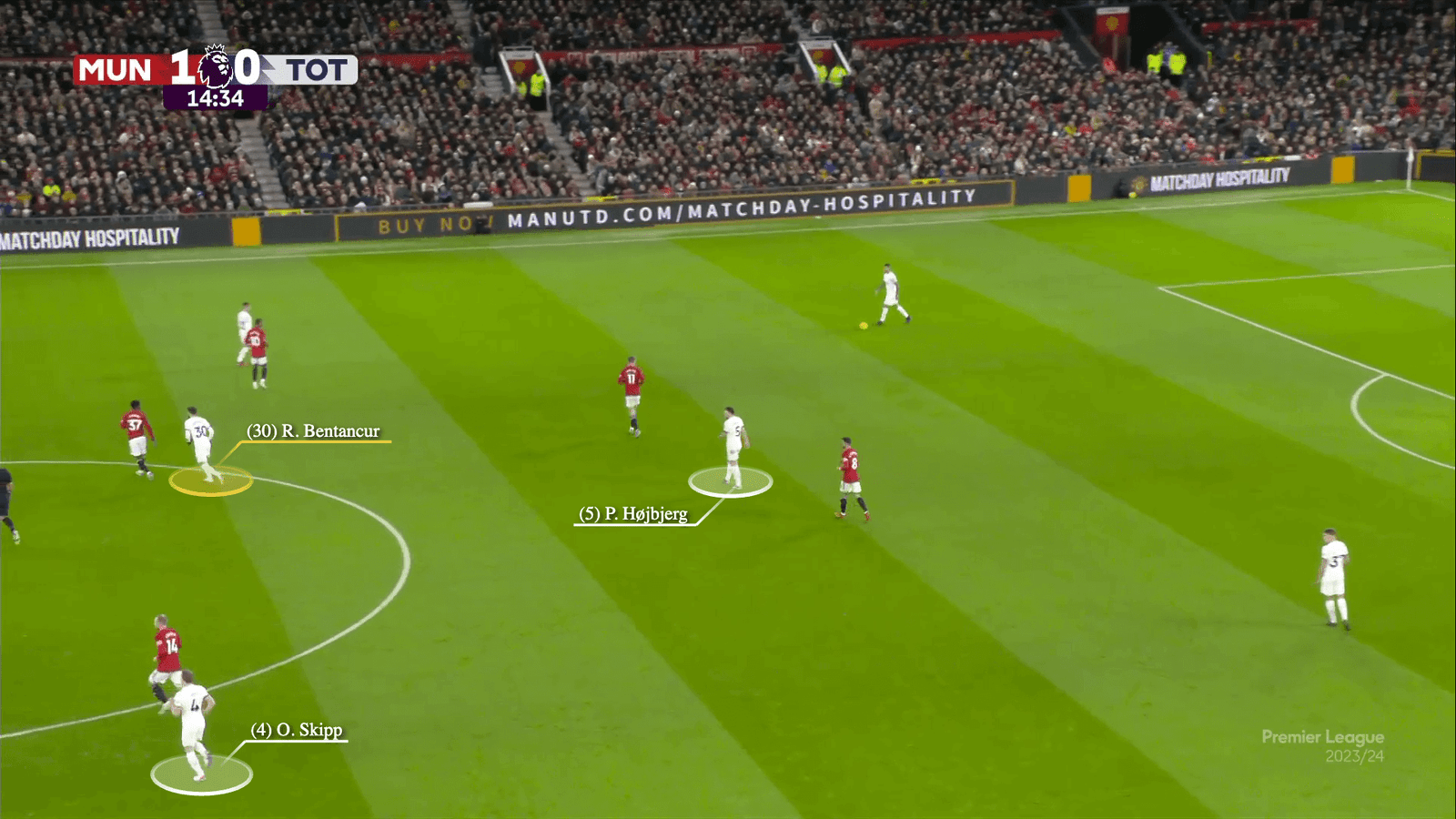
During the attack that leads to Spurs’ second goal of the match, Skipp’s movement forces Kobbie Mainoo to drop into the United penalty area. Bentancur spots this…

… and slides towards the left side to attack the space, with Porro’s narrow positioning covering for him in midfield. Timo Werner then plays a ball into Bentancur…

… who scores to make it 2-2.

The swift transformation of Tottenham from being a rigid team in the final third last season under Antonio Conte into a flexible unit in this one is a testament to the players, the coaching staff and Postecoglou.
(Top photo: Catherine Ivill/Getty Images)
Read the full article here


